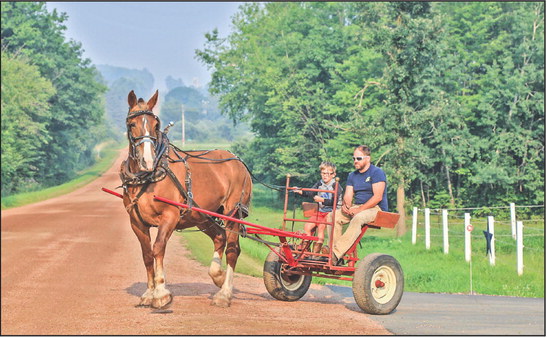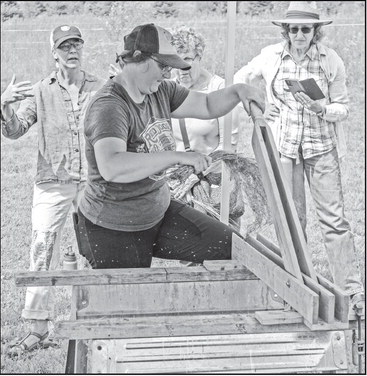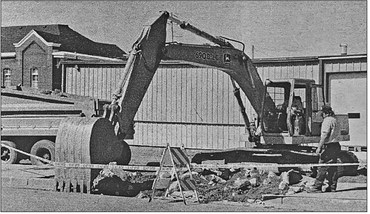Edgar looking for public input on comp plan revisions
Over the next month, Edgar officials are hoping to hear from residents on what they think about a set of proposed updates to the village’s comprehensive plan.
At a July 30 meeting, members of the village’s planning commission went over the 38-page document, which includes a wealth of information on Edgar’s parks, public utilities, businesses and demographics, as well as general projections for future development.
Copies of the draft comp plan are available online at www.vil.edgar.wi.us (scroll to the bottom) or at village hall and can also be requested by calling 715-352-2891.
The plan, which was last updated in 2025, anticipates the village will need 47 acres for new residential development and 60 acres for continued commercial and industrial growth between now and 2045. To make way for this growth, the village will need to use its zoning and subdivision ordinances to make land-use decisions.
“Under Wisconsin’s comprehensive planning law, since January 1, 2010, all land use- related actions must be consistent with the adopted comprehensive plan,” the plan states. “Edgar must therefore ensure that ordinances and policies are regularly reviewed and updated to reflect this plan’s vision.”
The commission tentatively scheduled its next meeting for Monday, Sept. 8, at 6 p.m., an hour before the village committees have their regular monthly meetings.
Commissioners also reviewed the results of the Edgar Forward survey, which has generated 112 responses since it was first circulated and posted on the village’s website on June 23. The survey includes 30 questions meant to gauge residents’ satisfaction with the quality of life in Edgar and the services and amenities provided by the village.
Most of the people who responded to the survey have lived in the village for 10 or more years, with close to 30 percent of the respondents identifying themselves as lifelong residents. On a five-star scale, “green space” and “community and neighbors” ranked the highest among the respondents, while “local businesses” and “street design and maintenance” were on the low end (all rankings fell between three and four stars).
When asked to comment on “what stands out as unattractive in Edgar,” many of the respondents identified vacant or rundown buildings in the downtown area and lack of local businesses and services. As a follow-up, when asked to choose among various descriptions of Edgar as a village, the top responses were “friendly” (36 percent) and “declining” (26 percent), followed by “stuck” (22 percent).
One respondent summarized Edgar’s current condition this way: “There are many wonderful qualities, and even more wonderful people, who are part of the Edgar community. We have to figure out how to stay connected to our past without living in the past.”
Respondents highlighted the lack of space for new, affordable housing and jobs as areas of concern for the village, and several expressed a desire for more job opportunities and business expansions. Many current amenities ranked highly, including the food trucks during the summer, the Scotch Creek woodland preserve and the minnow ponds. Concerts in the Park, library services and ballpark events also received a lot of votes.
When it comes to additional “quality of life” services that could be offered, respondents listed everything from an expanded farmers market and community gardens to splash pads and pickleball courts.
Village administrator Jennifer Lopez said the village has been getting about $19,000 a year from the Shortner Foundation for improvements at Shortner Park, and it also includes $10,000 in its own budget for park projects.
Residents who responded to the survey were generally satisfied with the village’s parks and emergency services, but they were a little less certain about the village’s administration, board of trustees, website and the police department, with many of them choosing “neither satisfied nor dissatisfied.”
When asked about the ongoing Scotch Creek restoration project, most respondents were at least somewhat familiar with the project, and 64 percent said they would support using tax dollars to support restoration of the creek.
Updated information
The following information is included in the updated comp plan based on data from the 2020 U.S. Census:
■ The median age is 52, with 22 percent of the population between the ages of 50 and 59 and 10 percent between 10 and 19.
■ The median household income is $61,442, with a per capita income of $42,868, which is about 10 percent higher than average in the Wausau metro area. Nearly 8 percent of the population is living below the poverty line.
■ The village’s 2020 population of 1,749 is divided among 703 households, with an average of about two people per household. Edgar has 709 housing units, with a median value of $165,900 for owner-occupied homes, which make up 74 percent of local housing units.
■ Edgar’s population increased by 6.7 percent from 2000 to 2010, but then dipped 2.6 percent between 2010 and 2020, with the number of residents projected to rebound slightly by 2040.
While the median age of residents continues to rise, the share of the population under 18 has remained the same or dropped slightly over the last couple of decades.
“This trend signals a need for increased services and housing options tailored to older residents,” the plan states.
■ As of 2022, an estimated 726 residents were employed, with a majority of them commuting an average of 22 minutes outside the village for their jobs.
■ Manufacturing employs 195 residents, accounting for 32.2% of the workforce, followed by 73 residents working in healthcare, 69 in retail, and others employed in construction, finance, education and real estate.
Conditional use permit
Commissioners voted to recommend a conditional use permit for the property at 388 W. Beech St., allowing owner Kyle Imhoff to maintain a “tourist room” in the commercial building. Imhoff’s brother has been living in the commercial garage, which is only allowed as a conditional use in the village’s B-1 Central Business District.
Lopez said Imhoff does not plan on renting out the space, but does want to continue allowing his brother to live there.
In response to complaints from neighbors about vehicle repair activities in the building, commissioners included a condition that the road right-of-way next to the building be kept clear and also recommended a privacy fence be installed next to a neighboring house. The permit will also be contingent on Imhoff obtaining and maintaining a state lodging license through Marathon County.
If noise is an issue in the future, Lopez said the neighbors can always file complaints with the village or the Marathon County Sheriff’s Department.



